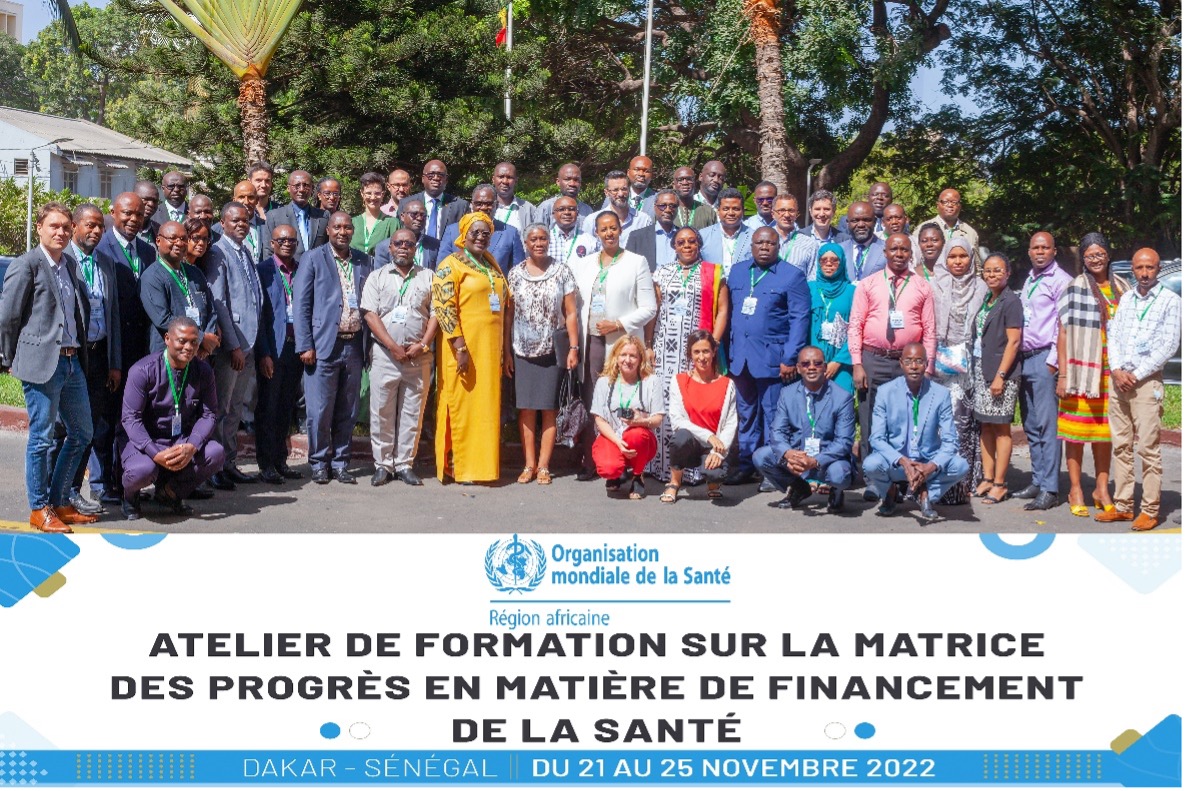From November 21 to 25, in Dakar, the WHO organized a training session on the health financing progress matrix for French-speaking African countries. Delegations from 18 countries came together to learn how to apply the new health financing tool in their countries, and how the matrix can help monitor and stimulate progress towards universal health coverage (UHC).
The Health Financing Progress Matrix (HFPM ) is a relatively new tool in the toolbox of health financing decision-makers and advisors. It draws on more than 20 years of WHO experience and on empirical studies of aspects of health financing that are likely to promote progress towards universal health coverage. Given its novelty – to date, only two countries have officially published an assessment report on the matrix – the WHO health financing team in Geneva, in collaboration with WHO AFRO, organized a training session for French-speaking countries. Eighteen countries accepted the invitation. The room was packed with representatives from ministries of health (and even, in one case, a representative from the ministry of finance), WHO country office “health systems strengthening” focal points, P4H network country focal points, researchers and international experts. A team of WHO facilitators guided participants through sessions covering the motivations behind the tool, the stages of assessment, the place of the matrix among other health financing tools such as national health accounts (see also this event which tells us more about their differences), and how MPFS can be integrated into different political and technical dynamics. During the afternoons, the 18 national delegations worked on the application of the matrix in their country’s context, and on its use by national decision-makers. This co-production work was supported by various experts, notably the P4H country focal points whose role is precisely to act as neutral facilitators of policy dialogue on health financing systems and social protection in the countries where they are deployed or appointed.
Here are just a few aspects of the event that can be highlighted.
MPFS does not replace existing tools: it complements them by providing a more prescriptive qualitative analysis.
The MPFS is presented as the ‘little sister’ of national health accounts and national financing strategies. Drawing on the evidence gathered over recent decades on what can help progress towards CSU, the matrix assesses countries’ progress towards 19 desirable attributes.
This normative analysis is preceded by an initial mapping and analysis of the country’s main healthcare financing arrangements, in particular to understand where the country stands in terms of pooling resources. Based on this descriptive work, in the second stage, experts produce an assessment of the financing system by answering 33 questions. For each, an assessment such as “emerging”, “progressing”, “established” or “advanced” is to be made. The WHO has produced a number of reference documents. The country assessment guide provides a context for each question and also describes what progress looks like. On this basis, the country can draw up relevant recommendations.
In Dakar, countries proposed different applications of the matrix in their political-technical cycle. Senegal, for example, wants to use the matrix to evaluate the health financing aspect of their 2017 national health financing strategy. Niger suggested using the matrix on a regular basis to check progress towards CSU. Mauritania intends to use the matrix to establish the baseline for their new health financing strategy. Some countries, such as Comoros, will wait until the end of the electoral phase to carry out the assessment, taking into account the political dynamics. Still others, like Madagascar, want to take advantage of the electoral period to complete the assessment and be ready with recommendations for a new government.
There's no single way to fill the matrix
As for the first stage, participants discussed what might justify the inclusion of a health financing scheme in the map to be drawn up. Ultimately, this may differ from country to country, given how their schemes are organized (is there a distinct governance attached?), what they fund (is it a separate, different or complementary set of benefits to the others?) and how they are financed (do they bring new funds to the healthcare sector?).
During the workshop, the example of Sierra Leone was taken as a concrete example. With regard to stage 2 of the matrix, participants were able to hear about the various challenges encountered in this country. The qualitative nature of the questions may lead to some discrepancies in assessment, already at country level or later at the level of external evaluators. For example, one of the 33 questions relates to the stability and predictability of the flow of public funds to providers; if the flow of public funds is basically zero, does that count as stable and predictable? Probably, but is it desirable? Maybe not. The qualitative aspect of the matrix provided food for thought for the participants, and gave rise to many lively discussions. This is one of the reasons why an external evaluation is essential to ensure the quality of evaluations carried out using the Health Financing Progress Matrix.
We are all "political entrepreneurs of the CSU"
Like many of the participants, I particularly enjoyed a session led by Bruno Meessen devoted to the five dynamics shaping the development of policies to strengthen health systems (these dynamics were identified by Dr Belghiti, when he was Secretary General of the Ministry of Health in Morocco). This framework posits that technical and political leaders in ministries of health are constantly faced with managing the dynamics of services, programming, policy, reform and capacity building. According to Bruno Meessen, a politico-technical tool like the MPFS will be useful insofar as it enables us to manage this bundle of dynamics.
The countries took the time to analyze their own health financing milestones over recent decades and the dynamics prevailing today, based on Dr Belghiti’s analytical framework. This further contextualized the matrix and showed how it can be a useful tool for strengthening health systems and, ultimately, moving towards UHC. As Bruno Meessen put it, we are all “political entrepreneurs of the CSU”, and it’s up to us to navigate the different dynamics to move financing systems towards it. From this angle, we can see the potential of the matrix in the toolbox of healthcare finance practitioners.
All national delegations left with a roadmap and a contextualized presentation to discuss with stakeholders back home how to move forward with the matrix assessment. WHO will provide the necessary support and ongoing monitoring to realize the full potential of the matrix. Countries can also rely on P4H country focal points.
The training ended just in time for participants to watch the host country’s soccer team, Senegal (the Lions of Teranga), win their second World Cup match in Qatar. All in all, a very successful week!


